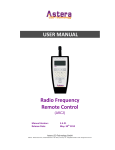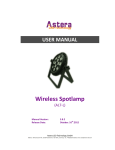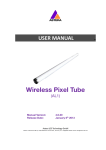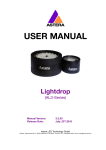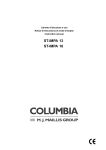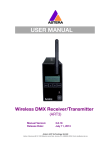Download Astera ART3 User manual
Transcript
USER MANUAL Wireless DMX Receiver/Transmitter (ART3) Manual Version: Release Date: 3.2.20 July. 23rd.2010 Astera LED Technology GmbH Address : Nahestrasse 68-70, 55593 Rüdesheim an der Nahe, Germany Tel.: +49(0)6536-355361 Email: [email protected] 1 Table of Contents 1 Table of Contents......................................................................................2 2 Safety........................................................................................................3 3 Getting Started.........................................................................................4 3.1 Introduction................................................................................................4 3.2 Overview....................................................................................................5 3.3 Mounting/Connection...................................................................................6 3.4 LCD Display.................................................................................................6 3.5 Navigation...................................................................................................6 3.6 Radio PIN .................................................................................................6 4 Operation Modes.......................................................................................7 4.1 DMX Transmitter.........................................................................................7 4.2 RC Transmitter ...........................................................................................7 4.3 DMX Receiver..............................................................................................8 4.4 RC Receiver................................................................................................9 4.5 Control Lamps...........................................................................................10 5 Setup.......................................................................................................11 6 Technical Data........................................................................................14 7 Troubleshooting......................................................................................15 8 Appendix.................................................................................................16 8.1 Appendix 1: DMX tab for RC Transmitter mode............................................16 8.2 Appendix 1: Customizable Programs...........................................................18 9 Disposal...................................................................................................19 2 2 Safety Before you operate the unit, read this manual carefully. Make sure to keep the manual, in case you need to consult this manual again or you give the unit to another person. Always make sure to include this manual if you hand out the unit to another person. Keep in mind that this manual cannot address all possible dangers and environments. Please use your own caution when operating. Do not operate the unit in areas where the usage of radio frequency or mobile phones is prohibited, like for example in airplanes, or when it may cause interference or danger. Only qualified personnel may repair this product. Don't open the case. This device conforms to CE -or- FCC regulations, see type label! This device radiates in the 868 MHz or 915 Mhz bands. Always make sure, that your national regulations allow the use of this device! 3 3 Getting Started 3.1 Introduction Astera's ART3 is a wireless DMX receiver/transmitter that can be used to control a setup of Astera Lamps and/or third party lamps with a DMX control desk. There are five operation modes: 1. DMX Transmitter: Transmits one DMX universe that will be received by all light fixtures or Wireless DMX receivers that are set up appropriately. 2. RC Transmitter: the ART3 controls Wireless Astera lamps, the same way an ARC2 remote control would do but the parameters are set by an DMX control table. The whole light setup can be controlled in a way the ARC2 would do but there is a DMX desk in control. The basic advantages of this operation mode are a higher range and that data is only sent during changes. With only 20 DMX channels you can control a whole setup of lamps. 3. DMX receiver: one DMX universe can be received. 4. RC Receiver This mode is useful to integrate third party RGB lamps into a remote controlled light setup. Up to 32 RGB fixtures can be connected to the DMX output, all controllable individually. The ART3 will replay all the programs that can be set up by the remote control. 5. Control Lamps The ART3 can work as a simple remote control to set programs and colors similar to the ARC2 remote control. This is useful if you forget to bring your ARC2. 4 3.2 Overview Antenna LCD Display Navigate through menu Confirm Back / Menu Power on/off 5 Color Meaning XLR red Ready to transmit, XLR is INPUT INPUT red, flickering Transmitting, XLR is INPUT INPUT green Ready to receive, XLR is OUTPUT OUTPUT green, flickering Receiving, XLR is OUTPUT OUTPUT 3.3 Mounting/Connection 3.4 LCD Display Definition of symbols: [1] - Receiving [3] - Transmitting [4] - Settings are stored in the memory (shown by a short blinking of this symbol) [5] - Synchronization between units is active [8] - Battery status 3.5 Navigation Navigation is done over the + and – buttons. Enter confirms a selection or moves deeper in the navigation. Back aborts a selection or moves up in the navigation. In the top level of the navigation you can choose between the 5 operation modes and the setup menu. 3.6 Radio PIN Astera offers the possibility to operate several ART3 that are in reach of each other without interfering into each others data. Up to 5 different radio PINs can be set for this. To set a radio pin, choose SETUP, then RADIO PIN and choose a unique number. This has to be performed for both ART3 that are communicating with each other or for an ARC2 and ART3 if they are to communicate on a special radio channel. Although you can use up to five pairs of ART3 or ARC2 in one room it is recommended not to place them closely together. At least 1m of disctance should be between the transmitting units to avoid radio interferences. Their performance is influenced by the occupation of the available frequency bands! 6 4 Operation Modes As there are numerous settings, it is recommended to do a FACTORY RESET before setting them up. This can be found in the SETUP menu (chapter 5) As already explained in paragraph 3.1 on page 5, there are five basic operation modes: 1. DMX transmitter 2. RC transmitter 3. DMX receiver 4. RC receiver 5. Control Lamps To select a different operation mode, press the plus and minus key until you find the desired mode. Then press Enter to confirm. 4.1 DMX Transmitter Simply choose DMX TRANSMITTER to start this mode. The ART3 is already set to DMX Transmitter when you get it or after you perform a Factory Reset. As soon as the XLR connector detects a DMX signal the ART3 starts transmitting. This is indicated by a flickering blue power-LED. When the DMX signal is lost, the transmission is interrupted. The DMX data is compressed to fit the bandwidth of the wireless link. Due to this fact, the frame rate depends on the amount of changes done in the DMX stream between each frame. Assuming a good RF link, the refresh rate should be at a minimum of 10 Hz; usually it will stay at 20 Hz – 44 Hz. 4.2 RC Transmitter To start this mode, choose RC TRANSMITTER in the top navigation and confirm with Enter. This operation mode offers several advantages over the Wireless DMX modes and should be preferred over the DMX Transmitter operation mode. Setting up this operation mode takes longer then for the DMX Transmitter mode but the advantages are: 1. Much higher RF range. 2. Only 20 DMX channels are needed to control a whole light setup. 3. Easy setup of light fixtures. 4. Less programming effort needed to archive varied light shows. 7 When choosing the RC Transmitter mode you can control ART3 transmitters as well as wireless Astera lamps. Two values can be set in the RC Transmitter mode: RC DMX Address Chooses the ART3's input DMX address from 0-511. DMX Tab Three DMX tabels that control the lamps can be chosen. Each one has a predefined set of DMX channels and their effects on the lamps. A table showing the DMX channels for each tab can be found in Appendix 1. While the DMX Tabs STANDARD and EXTENDED offer the same possibilities as the ARC2 remote control just that you input the values directly at a DMX light controller the DMX Tab SIMPLE RGB offers an easy way to set the same color to all lamps in reach of the ART3. 4.3 DMX Receiver To start this mode, choose DMX RECEIVER in the top navigation and confirm with Enter. As soon as a Wireless DMX signal is received by the antenna, the power-LED start flickering green, and the XLR connector outputs DMX data. If the signal is lost, the transmission stops. DMX Failure: When in the DMX Receiver mode you can also set a value for DMX Failure in case the DMX signal is interrupted and the ART3 does not receive any DMX data. Four values are possible: Hold: If the DMX reception times out, the output keeps unchanged and the last received DMX frame is displayed. Emergency Light: If the DMX reception times out, the light turns white. Blackout: If the DMX reception times out, all light turns black. Auto Program: If the DMX reception times out the ART3 displays any of the 20 preprogrammed programs. 8 4.4 RC Receiver To start this mode, choose RC RECEIVER in the top navigation, confirm with Enter. By using the RC Receiver mode, third-party RGB lamps can be integrated in a light setup that is not controlled by Wireless DMX but by the ARC2 remote control. Up to 32 externally connected RGB fixtures can be controlled individually. The ART3 has to be setup to the number of connected pixels, to replay programs correctly. This is done using the AUTO PIXELS parameter. Apart from Auto Pixels a range of values can be set to control the connected third-party lamps directly from the ART3 without the need for an ARC2 remote control: Auto Pixels Sets the number of pixels that replay programs. Setting the value to ten means that a program will stretch over ten lamps. Local Group Assigns the lamps to one of the four groups for easy addressing. Local Set Number Assigns the lamps to one of 256 possible sets for easy addressing. Program Plays one of 20 pre-defined programs that can be customized with colors, intensity, power scheme, speed, fade, directions, etc. Intensity Sets the brightness of the lamps. Power Scheme Three different power schemes can be set to optimize the lamp for high-brightness, maximum runtime or normal playback. Speed Sets the speed with which a program is played. Fade Sets the fading transitions between between different colors from hard transitions to smooth transitions. Direction Sets the direction of a program and whether it loops continuously or is played only once. Strobo Speed Starts the strobe-light and defines the frequency of the strobe effect Random Mode Switches a random mode on which displays programs at a changing rate. Random Fade Defines the random fade. Random Speed Defines the random speed. Groups GROUPS defines over how many of the 4 Groups a displayed program stretches. Usually this is set automatically by the ART3. Offset Offset defines where the LOCAL GROUP starts. Usually this is set automatically by the ART3. Chain Size Creates a chain of lamps that enable programs to stretch over several lamps. Position in Chain Assigns a position inside the chain to all lamps connected to the ART3 Set Size Defines over how many lamps a set stretches. Position in Set Defines which position in a set a lamp has. Color 1 Sets color 1 that is used to display programs 9 Color 2 Color 3 Color 4 Sets color 2 that is used to display programs Sets color 3 that is used to display programs Sets color 4 that is used to display programs 4.5 Control Lamps To start this mode, choose CONTROL LAMPS in the top navigation and confirm with Enter. The ART-1 can be used as a remote control, providing basic functionality of the ARC2 remote control. Although the ARC2 is easier to control as it has more buttons and a more compact size, the ART3 can do most of the ARC2 functions in case no ARC2 is available. Target Lamps Offers a range of possibilities to target several lamps of all the lamps in range. It is possible to target lamps by type, serial number, group, set number or by tapping several lamps Program Plays one of 20 predefined programs that can be customized with colors, intensity, power scheme, speed, fade, directions, etc. Intensity Sets the brightness of the lamps. Power Scheme Three different power schemes can be set to optimize the lamp for high-brightness, maximum runtime or normal playback. Speed Sets the speed with which a program is played. Fade Sets the fading transitions between between different colors from hard transitions to smooth transitions. Direction Sets the direction of a program and whether it loops continuously or is played only once. Strobo Speed Starts the strobe-light and defines the frequency of the strobe effect Random Mode Switches a random mode on which displays programs at a changing rate. Random Fade Defines the random fade Use Random Cols Uses random colors to display programs Color 1 Sets color 1 that is used to display programs Color 2 Sets color 2 that is used to display programs Color 3 Sets color 3 that is used to display programs Color 4 Sets color 4 that is used to display programs 10 5 Setup The setup offers advanced settings that can be done before or after an event like factory reset, forming groups of lamps, calibrating colors and setting a keylock when giving away the ARC2. To enter the SETUP menu, while in the top level of the navigation press the minus button ( - ) until you see SETUP, then confirm with Enter. If you are not sure in which level you are, press the home button, to get to the top level. If SETUP does not appear on pressing the ( - ) button, check the KEYLOCK setting! Create a Set: Sets are similar to groups and combine several lamps which can be ad dressed at the same time and arranged in a preferred order to stretch effects over them. Unlike groups, a huge number of sets (256) can be programmed and targeted with the Target Lamps button. A set can also be applied to only 1 lamp if this lamp needs to be targeted quickly. Create a Chain: Chained lamps will stretch their effects and programs over several lamps. For example the FLAG RUNNING program can send a pixel running one AL6 until it reaches its edge, then continue on the next AL6. To allow a smooth running along the chain, correct positions have to be assigned to each lamps. DMX Setup: Some Astera lamps do not have a LCD-display so the ARC2 can be used to set them up for DMX usage. Also, Astera lamps with LCD-display might be easier configured remotely for DMX because their display cannot be reached. DMX Address: Sets the DMX address DMX Pixels: All pixels: Every pixel can be controlled individually by DMX Reduced Pixels: Pixels are combined to achieve a fewer pixel count for easier control. Please refer to the manual of the specific device to see how many pixels will be present on DMX when this setting is chosen. One Pixel: The device can be controlled with only three DMX channels. All pixels are combined into one. DMX Tab: Several different DMX tables can be chosen. 11 RGB S RGB S..: For each pixel there are three channels RGB and one channel stroboscope. RGB RGB S S..: All RGB channels are followed by all stroboscope channels. Effect Mode Fix: The 4 user colors are controlled by one channel per color (generates basic colors). Effect Mode RGB: The 4 user colors are controlled by three DMX channels each. Strobe: Single: Multiple: Off: DMX Failure: Remote Setup: One DMX channel is supplied for the control of the stroboscope function and all pixels will strobe Identical. When using this setting, DMX TAB should not be set to RGB S RGB S .. For each pixel, the stroboscope can be controlled individually. Stroboscope is turned off globally. Sets the behavior of the light in case of an interrupted DMX signal. Hold: The output keeps unchanged, the last received DMX frame is displayed. Emergency Light: If the DMX reception times out, the light turns white. Blackout: If the DMX reception times out, all light turns black. Usually all configuration settings, like changing the DMX address, chain configuration and so on is done directly on the units. This might not be feasible if several units with the same settings have to be con figured with the same settings or a unit is not equipped with a LCD-dis play. Remote Group chooses one of the 4 groups. Input Select lets you choose between XLR DMX, Wireless DMX, Remote Control function. Standalone or Auto. Input Select If a lamp has several input signals (for example it is connected to a DMX cable but should be targeted by the ARC2) the preferred input signal can be defined XLR DMX for the signal of wired DMX Wireless DMX for the signal of wireless DMX Remote Control for the radio signal of the ARC2 12 Standalone AC Failure Manual White Calibration: to keep the last input signal (for example 1 color) until another input source is chosen. Auto Automatically chooses an input source Emergency Light If no AC signal is detected, the light turns white. No Action no action Blackout If no AC signal, all light turns black. You can enable automatic white calibration or manually adjust the red, green and blue levels that are used to display white color. Radio Pin: The Radio Pin makes it possible for different customers to operate their lamps at the same place without influencing other lamps. The 4-digit pin can be set to a unique value and paired with selected lamps. To activate the radio pin, choose a pin on lamps and remote control, then press PAIR WITH LAMPS. Factory Reset: Selecting THIS REMOTE will reset all settings including keylocks and all MEMORY programs. Resetting LAMPS will ask you to tap individual lamps to select which of the lamps in range you want to reset. For event rental companies a factory reset of the ARC2 remote should be done after each rental job to avoid misleading settings from customers. 13 6 Technical Data General Temperature (operation) 5 °C – 40 °C Temperature (transport) -25 °C – 55 °C (70 °C for 24h) Altitude up to 2000 m over sea level Environment indoor Input Power 110-240V, 50-60Hz AC Radio Frequency RF coverage 50m up to 300m Frequency Europe: 868.000 MHz – 869.750 MHz US: 902MHz – 928 MHz WARNING The user must make sure, that the national regulations allow the operation of this RF device! If this is neglected, serious harm may occur! 14 7 Troubleshooting Faulty condition Cause Troubleshooting Units are out of sync Adjustment of the SPEED parameter Press SEND button or change can cause deviation between the PROGRAM. units; also the units will drift out of sync after a few hours. Units behave incorrectly Due to the vast number of settings, Do FACTORY RESET on units and/or one can not always predict behavior remote control. of the units, if setup was already done earlier. One/a few units don't play the correct program, even if it was set up earlier. If a unit is powered up after the light scene was setup with the remote control, if will not work correctly. Press SEND button on remote control to update the unit. One/a few units don't react on the remote control. Its possible, that those units are set to a group, that is not activated in the remote control under Group. Change Group setting or put unit(s) into another group. The display of a unit is showing BLACKOUT, and there is no light output. Either the unit is set to BLACKOUT mode, or DMX-FAILURE/AC FAILURE is set to BLACKOUT and one of these conditions persist. Press I/O on remote control and set to DISABLED. Check settings of DMX-FAILURE/AC FAILURE. Maybe do FACTORY RESET. One ART3 is on DMX Transmitter The two ART3 are set to different Go to SETUP then RADIO PIN and and is sending data and one ART3 is radio pins and don't correspond with choose a unique pin number. Do set to DMX Receiver but does not each other. this for both units. receive any data. 15 8 Appendix 8.1 Appendix 1: DMX tab for RC Transmitter mode SIMPLE RGB STANDARD EXTENDED 1, 2, 3 Color of all lamps in group 1 4, 5, 6 Color of all lamps in group 2 7, 8, 9 Color of all lamps in group 3 10, 11, 12 Color of all lamps in group 4 1 Dimmer 2 Strobe 3 Program 4 Speed 5 Fade 6 Direction: 0..63 loop+ffw, 64..127: ffw, 128..190: rew, 191..255: loop+rew 7 Send to groups 8 Send-mode: 00..10 send on modify, 11..245: do not send, 246..255: send all parameters 9, 10, 11 C1 (color channel 1) 12, 13, 14 C2 (color channel 2) 15, 16, 17 C3 (color channel 3) 18, 19, 20 C4 (color channel 4) 1 Dimmer 2 Strobe 3 Program 4 Speed 5 Fade 6 Direction: 0..63 loop+ffw, 64..127: ffw, 128..190: rew, 191..255: loop+rew 7 Send to groups 8 Send-mode: 00..10 send on modify, 11..245: do not send, 246..255: send all parameters 16 17 9, 10, 11 C1 (color channel 1) 12, 13, 14 C2 (color channel 2) 15, 16, 17 C3 (color channel 3) 18, 19, 20 C4 (color channel 4) 21 Set-Address: if > 0: dont use groups setting, send to this set# 8.2 Appendix 1: Customizable Programs Name ONE COLOR STATIC TWO COLOR STATIC THREE COLOR STATIC FOUR COLOR STATIC ONE COLOR FADE Light Effect Used colors All pixels show the same color C1 Same as ONE COLOR STATIC, but C1 C2 not all pixels show the same color, C1 C2 C3 they are divided into 2, 3 or 4 parts. C1 C2 C3 C4 All pixels show the same color, but C1 C2 C3 C4 the color changes between all four USER COLORS. TWO COLOR FADE Same as ONE COLOR FADE, but not C1 C2 C3 C4 all pixels show the same color, they C1 C2 C3 C4 THREE COLOR FADE are divided into 2, 3 or 4 parts. FOUR COLOR FADE C1 C2 C3 C4 SIMPLE RUNNING All pixels have C1 color, except one, C1 C2 that is running over them with C2. DOUBLE RUNNING Same as SIMPLE RUNNING, but C1 C2 two pixels are running over the background, in opposite directions. TWO COL RUNNING Same as DOUBLE RUNNING, but C1 C2 C3 the two pixels are of different color. FLAG RUNNING A “flag” consisting of three color C1 C2 C3 C4 stripes is running over the background. DOUBLE FLAG RUNNING Same as FLAG RUNNING, but two C1 C2 C3 C4 flags are running in opposite directions. SPIRAL 4 COLORS The color of all pixels is changing C1 C2 C3 C4 pixel by pixel from one color to the next. If the geometry of the unit allows it, the direction is circular. SPIRAL 2 COLORS Same as SPIRAL 4 COLORS, but C1 C2 the movement starts at both and in opposite directions, and moves back after all pixels are changed. RAINBOW A moving rainbow is shown on the none units. FIRE A flickering fire-like effect is C1 C2 displayed. C1 is the background color, randomly pixels flash and flicker with C2. ROTOR The rotor programs are much like the C1 C2 C3 C4 FADE programs, but if the units are of tower-like shape, then a clockwise running rotor can be seen. ROTOR SPLIT 2 Same as ROTOR, but two rotors in C1 C2 C3 C4 opposite directions are running. ROTOR SPLIT 4 Same as ROTOR, but four rotors in C1 C2 C3 C4 opposite directions are running. 18 9 Disposal Follow local ordinances and/or regulations for disposal! PACKAGING: The unit is shipped in protective packaging. This packaging can be recycled! UNIT: Don't throw the unit into the garbage at the end of its lifetime. Make sure to dispose is according to your local ordinances and/or regulations, to avoid polluting the environment! BATTERIES: Don't throw empty batteries into the garbage! Bring them to a collecting point for used batteries! 19 This instruction manual is part of the device and persons operating the device must have access to it at any time. Safety precautions mentioned in the instruction manual have to be observed. If the device is being sold, this instruction manual has to be included. Translations If the device is being sold, this instruction manual has to be translated into the national language of the destination country. If discrepancies occur in the translated text, the original instruction manual has to be used to solve them tor the manufacturer has to be contacted. ©2010, Astera LED Technology GmbH All rights reserved Rüdesheim an der Nahe, Germany 20




















